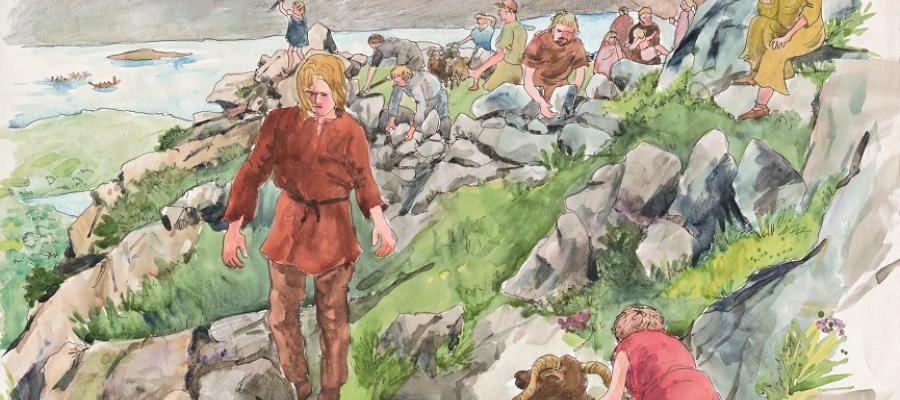From Øygarden towards Hjeltefjorden (Helge Sunde).
Hordaland – a historic region
“It was on such a chilly, silver-grey morning that the Hørde folk, the Harudes of Caesar and Tacitus, must have come running in from the sea on the wind at sunrise; at last from the Danish peninsula in the final phase of the great Folk migration, as it either crumbled under the overwhelming superior power or was pushed forward only by small folk, from the misery of many years of famine, just like the early settlers of Iceland to find better long-lasting homes; they took land for one reason or another not on the southern tip of Norway or Lister, but north of Karmøen and in the fjords of Hardanger, they sought shelter from the sea winds” This is the poet Hans E.Kinck’s lively description in his book: “Places and folk” of the emigration of the Horda people to western Norway. But what are his sources?
An extract from the text of Jordanes’ book on the Goths from the 6th century AD. Here is the translation: “(the inhabitants of Sweden (Suetidi) are known to be the biggest of these peoples. But this is also true of the Danes (Dani) who come from the same people and who drove the Herul people away from their area. Like all Scandinavian people they have a reputation for their height. We also find here the inhabitants of Grenland (Grannii), Egdene (A(u)gandzi), the Island people (Eunixi e t), Hovedrygene (Aetelrugi), Hordane (Arothi), Raumane (Raumi). Some years ago Rodvulf rule over these, but he despised his own kingdom and submitted to the Goth king Teoderik where he got what he wanted. These tribes fought with savagery against the Germans.(Translated extract fromJordanes: Svennung, J. (1967) Jordanes und Scandia, s. 2-3. Skrifter (Kungl. humanistiska vetenskapssamfundet i Uppsala), nr. 44:2A. Uppsala.)
Gulatinget in the High Middle Ages comprised Egdafylke, Rygjafylke and Sunnmørafylke, in addition to Hordaland, Hardanger, Voss, Sogn og Fjordane. These latter areas belonged to the area of jurisdiction of the oldest Gulating. It may be that it was Njardarlog (the old name for Tysnes) that was the centre of the legal union of Nordhordland and Sunnhordland; probably the original area of the Horda folk. (map after Robberstad, K. (omsetjar) (1981) Gulatingslovi. 4. utg. Oslo, Samlaget.)
This is an initial from the introduction to the maritime administration period in the National Law from the first half of the 14th century. The initial shows the prow of a maritime administration ship. The system, of maritime administration was a great system of defence which all farmers were obliged to take part in. (from: Magnus Lagabøters Landslov. owner: Det Kongelige Bibliotek, København (Hardenbergske Codex. GKS 1154, 9v.)).
A reconstruction of a maritime administration boat shed and boat place at Bjelland in Stord, with a copy of the Kvalsund boat. Today this boat place has had to give way to Stord shipyard. It was here that the Viking shop from Føyno or Kårevik coastal administrative district was stationed. (AV-avd., UiB. Eigar: Bergens Sjøfartsmuseum (B.Sj 3188)).








